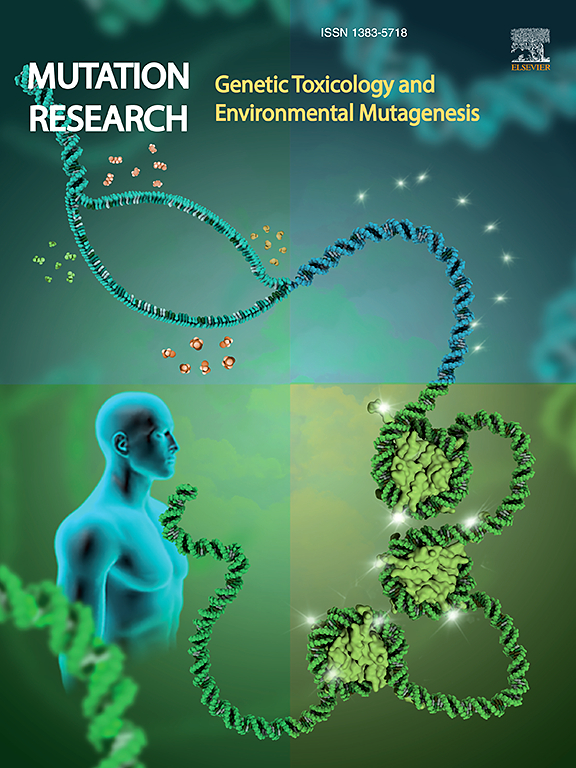PPAR-β/δ激动剂GW0742通过恢复DNA修复基因表达,减轻系统性红斑狼疮动物模型的DNA损伤和狼疮肾炎
IF 2.5
4区 医学
Q3 BIOTECHNOLOGY & APPLIED MICROBIOLOGY
Mutation research. Genetic toxicology and environmental mutagenesis
Pub Date : 2025-08-01
DOI:10.1016/j.mrgentox.2025.503881
引用次数: 0
摘要
系统性红斑狼疮(SLE)是一种持续性自身免疫性炎症性疾病,与肾损害风险升高相关。SLE的病因尚不清楚;然而,目前的研究越来越多地表明,DNA损伤的增加及其修复机制的缺陷可能导致其发病机制,因此有必要对该疾病进行识别和管理。近几十年来,SLE的治疗方法有了很大的改进。然而,专门针对潜在致病途径的药物,如潜在的DNA修复缺陷,是不可用的。在这种情况下,改善DNA损伤/修复改变的药物可能是治疗SLE的一种可能选择。我们研究了GW0742,一种过氧化物酶体增殖物激活物受体β/δ的激动剂,是否能改善雌性狼疮易感小鼠的肾功能和改善DNA损伤/修复改变。结果表明,重复给药GW0742显著改善狼疮易感动物骨髓细胞的DNA损伤/修复改变,如彗星试验所评估的那样。此外,GW0742通过降低Gadd45a和p53的表达,同时提高肾组织中Ogg1和Parp1的表达,恢复了狼疮易感小鼠受损的DNA损伤/修复途径。GW0742可恢复狼疮易感小鼠的肾脏氧化还原平衡。它还改善了与狼疮肾炎相关的生化标志物的改变,如尿蛋白和白蛋白、血清肌酐和BUN水平的降低。GW0742的保护效果通过其降低炎症标志物MPO活性和改善SLE肾脏组织学特征的能力得到证实。这表明GW0742是一种很有前景的治疗SLE及其相关并发症的新型药物。本文章由计算机程序翻译,如有差异,请以英文原文为准。
The PPAR-β/δ agonist GW0742 alleviates DNA damage and lupus nephritis in an animal model of systemic lupus erythematosus via restoring DNA repair gene expression
Systemic lupus erythematosus (SLE) is a persistent autoimmune inflammatory disease associated with an elevated risk of kidney damage. The etiology of SLE remains unclear; nevertheless, current investigations increasingly indicate that increased DNA damage and deficiencies in the mechanisms of its repair might contribute to its pathogenesis, necessitating the identification and management of the disease. Therapies for SLE have improved considerably over recent decades. However, drugs that specifically address the underlying pathogenic pathways, such as potential DNA repair deficiencies, are unavailable. In this situation, drugs that ameliorate the altered DNA damage/repair might be a possible option for treating SLE. We investigated whether GW0742, an agonist of the peroxisome proliferator activator receptor β/δ, improves kidney function and ameliorates DNA damage/repair alteration in female lupus-prone mice. The results demonstrate that the repeated administration of GW0742 significantly ameliorates DNA damage/repair alteration in the bone marrow cells of lupus-prone animals, as assessed by the comet test. Furthermore, the administration of GW0742 restored the impaired DNA damage/repair pathway in lupus-prone mice by decreasing Gadd45a and p53 expression while elevating Ogg1 and Parp1 in the kidney tissues. The administration of GW0742 recovered the disturbed kidney redox balance in lupus-prone mice. It also ameliorated the altered biochemical markers related to lupus nephritis, as demonstrated by reduced levels of urinary protein and albumin, serum creatinine, and BUN. GW0742's protective outcome was verified by its ability to diminish the increased inflammatory marker MPO activity and ameliorated kidney histological characteristics of SLE. This suggests that GW0742 is a promising novel therapeutic agent for managing SLE and its associated complications.
求助全文
通过发布文献求助,成功后即可免费获取论文全文。
去求助
来源期刊
CiteScore
3.80
自引率
5.30%
发文量
84
审稿时长
105 days
期刊介绍:
Mutation Research - Genetic Toxicology and Environmental Mutagenesis (MRGTEM) publishes papers advancing knowledge in the field of genetic toxicology. Papers are welcomed in the following areas:
New developments in genotoxicity testing of chemical agents (e.g. improvements in methodology of assay systems and interpretation of results).
Alternatives to and refinement of the use of animals in genotoxicity testing.
Nano-genotoxicology, the study of genotoxicity hazards and risks related to novel man-made nanomaterials.
Studies of epigenetic changes in relation to genotoxic effects.
The use of structure-activity relationships in predicting genotoxic effects.
The isolation and chemical characterization of novel environmental mutagens.
The measurement of genotoxic effects in human populations, when accompanied by quantitative measurements of environmental or occupational exposures.
The application of novel technologies for assessing the hazard and risks associated with genotoxic substances (e.g. OMICS or other high-throughput approaches to genotoxicity testing).
MRGTEM is now accepting submissions for a new section of the journal: Current Topics in Genotoxicity Testing, that will be dedicated to the discussion of current issues relating to design, interpretation and strategic use of genotoxicity tests. This section is envisaged to include discussions relating to the development of new international testing guidelines, but also to wider topics in the field. The evaluation of contrasting or opposing viewpoints is welcomed as long as the presentation is in accordance with the journal''s aims, scope, and policies.

 求助内容:
求助内容: 应助结果提醒方式:
应助结果提醒方式:


